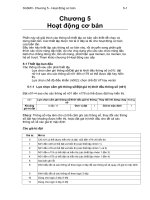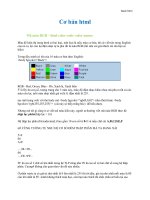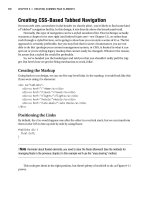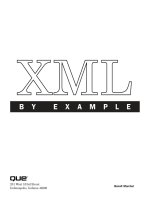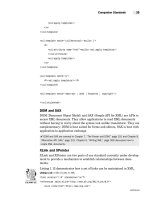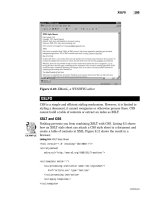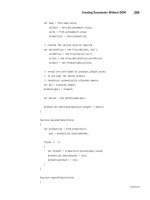Tài liệu XML by Example- P5 doc
Bạn đang xem bản rút gọn của tài liệu. Xem và tải ngay bản đầy đủ của tài liệu tại đây (532.22 KB, 50 trang )
Figure 6.10: XMetaL, a WYSIWYG editor
XSLFO
CSS is a simple and efficient styling mechanism. However, it is limited to
styling a document, it cannot reorganize or otherwise process them. CSS
cannot build a table of contents or extract an index as XSLT.
XSLT and CSS
Nothing prevents you from combining XSLT with CSS. Listing 6.5 shows
how an XSLT style sheet can attach a CSS style sheet to a document and
create a table of contents in XML. Figure 6.11 shows the result in a
browser.
Listing 6.5: XSLT Style Sheet
<?xml version=”1.0” encoding=”ISO-8859-1”?>
<xsl:stylesheet
xmlns:xsl=” /><xsl:template match=”/”>
<xsl:processing-instruction name=”xml-stylesheet”>
href=”article.css” type=”text/css”
</xsl:processing-instruction>
<xsl:apply-templates/>
</xsl:template>
185
XSLFO
EXAMPLE
continues
08 2429 CH06 2.29.2000 2:22 PM Page 185
Please purchase PDF Split-Merge on www.verypdf.com to remove this watermark.
Listing 6.5: continued
<xsl:template match=”keywords”>
<keywords><xsl:apply-templates/></keywords>
<section>
<title>Table of Contents</title>
<xsl:for-each select=”/article/section/title”>
<p><xsl:value-of select=”.”/></p>
</xsl:for-each>
</section>
</xsl:template>
<xsl:template match=”*”>
<xsl:copy><xsl:apply-templates/></xsl:copy>
</xsl:template>
</xsl:stylesheet>
186
Chapter 6: XSL Formatting Objects and Cascading Style Sheet
OUTPUT
Figure 6.11: The result in a browser
Figure 6.12 shows how it works. First, you apply an XSLT style sheet to the
document.
08 2429 CH06 2.29.2000 2:22 PM Page 186
Please purchase PDF Split-Merge on www.verypdf.com to remove this watermark.
✔ Refer to Chapter 5, “XSL Transformation,” for instructions on how to apply XSLT style
sheets with LotusXSL.
This XSLT style sheet creates an XML document, not an HTML document.
It reorganizes the document by creating a table of contents. The XSLT style
sheet also inserts a processing instruction that links the XML document to
a CSS style sheet.
The browser loads the XML document and the CSS style sheet to format it.
The major advantage of this solution, when compared to using XSLT to cre-
ate an HTML document, is that the final document is in XML. Therefore,
the final document still contains structure-rich markup.
187
XSLFO
Figure 6.12: Combining XSLT and CSS
XSLFO
If using CSS in combination with XSLT makes sense, why not offer CSS
features in XSLT? This is the reasoning behind XSLFO. XSLFO essentially
ports the CSS properties to XSL.
Listing 6.6 is a simple XSLFO style sheet. Figure 6.13 shows the result in
InDelv, currently the only browser on the market to support XSLFO.
Listing 6.6: A Simple XSLFO Style Sheet
<?xml version=”1.0”?>
<xsl:stylesheet
xmlns:xsl=” />xmlns:fo=” /><xsl:template match=”/”>
<fo:display-sequence
start-indent=”5pt”
end-indent=”5pt”
font-size=”10pt”
font-family=”serif”>
EXAMPLE
continues
08 2429 CH06 2.29.2000 2:22 PM Page 187
Please purchase PDF Split-Merge on www.verypdf.com to remove this watermark.
Listing 6.5: continued
<xsl:apply-templates/>
</fo:display-sequence>
</xsl:template>
<xsl:template match=”p”>
<fo:block>
<xsl:apply-templates/>
</fo:block>
</xsl:template>
<xsl:template match=”title”>
<fo:block
font-size=”13pt”
font-weight=”bold”>
<xsl:apply-templates/>
</fo:block>
</xsl:template>
<xsl:template match=”url”>
<fo:inline-link
destination=”text()”
color=”blue”>
<xsl:apply-templates/>
</fo:inline-link>
</xsl:template>
<xsl:template match=”date”/>
<xsl:template match=”keywords”/>
<xsl:template match=”abstract”/>
<xsl:template match=”copyright”/>
</xsl:stylesheet>
188
Chapter 6: XSL Formatting Objects and Cascading Style Sheet
08 2429 CH06 2.29.2000 2:22 PM Page 188
Please purchase PDF Split-Merge on www.verypdf.com to remove this watermark.
Figure 6.13: An XSLFO style sheet in a browser
An XSLFO style sheet is a list of XSL templates. The templates create for-
matting objects in the resulting tree. These formatting objects are equiva-
lent to CSS’ flow objects.
In Listing 6.6, you will recognize formatting objects for block boxes (for
example,
fo:block
) and inline boxes (for example,
fo:inline-link
). The
object properties are word for word taken from the CSS specification.
XLSFO also includes formatting objects specifically designed for XML; for
example,
fo:inline-link
creates a hyperlink. It has no equivalent in CSS.
This section is a very brief look at XSLFO because, at the time of this
writing, XSLFO has not achieved significant market acceptance. The
concepts, however, are very close to CSS.
What’s Next
Now that you know how to create and view XML documents, the next three
chapters will take you one step further and teach you how to manipulate
and create XML documents from a scripting or programming language.
189
What's Next
OUTPUT
08 2429 CH06 2.29.2000 2:22 PM Page 189
Please purchase PDF Split-Merge on www.verypdf.com to remove this watermark.
09 2429 CH07 2.29.2000 2:22 PM Page 190
Please purchase PDF Split-Merge on www.verypdf.com to remove this watermark.
7
The Parser and DOM
The previous chapters showed how to view and transform XML documents.
Style sheet is a powerful technology but it is limited to viewing and trans-
forming. When you have more specific needs, you need to turn to program-
ming. This chapter introduces how to read XML documents from
JavaScript or Java.
In this chapter, you learn
• what an XML parser is
• how to interface a parser with an application
• what DOM, the Document Object Model, is
• how to write JavaScript applications that use DOM
• how to write Java applications that use DOM
• which other applications use DOM
What Is a Parser?
A parser is the most basic yet most important XML tool. Every XML appli-
cation is based on a parser.
A parser is a software component that sits between the application and the
XML files. Its goal is to shield the developer from the intricacies of the
XML syntax.
Parsers are confusing because they have received a lot of publicity: There
are dozens of parsers freely available on the Internet. When Microsoft
shipped Internet Explorer 4.0 as the first browser with XML support, they
bundled two XML parsers with it.
Yet, if you ask for a demo of a parser, you won’t see much. The parser is a
low-level tool that is almost invisible to everybody but programmers. The
confusion arises because the tool that has so much visibility in the market-
place turns out to be a very low-level device.
09 2429 CH07 2.29.2000 2:22 PM Page 191
Please purchase PDF Split-Merge on www.verypdf.com to remove this watermark.
Parsers
Why do you need parsers? Imagine you are given an XML file with product
descriptions, including prices. Your job is to write an application to convert
the dollar prices to Euros.
It looks like a simple assignment: Loop through the price list and multiply
each price by the exchange rate. Half a day’s work, including tests.
Remember the prices are in an XML file. To loop through the prices means
to read and interpret the XML syntax. It doesn’t look difficult—basically
elements are in angle brackets. Let’s say the half-day assignment is now a
one-day assignment.
Do you remember entities? The XML syntax is not just about angle brack-
ets. There might be entities in the price list. The application must read and
interpret the DTD to be able to resolve entities. While it’s reading the DTD,
it might as well read element definitions and validate the document.
✔ For more information on how the DTD influences the document, see the section
“Standalone Documents” in Chapter 3 (page 79).
What about other XML features: character encodings, namespaces, param-
eter entities? And did you consider errors? How does your software recover
from a missing closing tag?
The XML syntax is simple. Yet, it’s an extensible syntax so XML applica-
tions have to be ready to cope with many options. As it turns out, writing a
software library to read XML files is a one-month assignment. If you were
to write such a library, you would be writing your own parser.
Is it productive to spend one month writing a parser library when you need
only half a day’s work to process the data? Of course not.
That’s why developers download a parser from the Internet or use the one
that ships with the development tool. This is the common definition of a
parser: off-the-shelf components that isolate programmers from the
specifics of the XML syntax.
If you are not convinced yet and if you’d rather write your own XML parser,
consider this: No programmer in his/her right mind (except those working
for Oracle, Sybase, Informix, and the like) would write low-level database
drivers. It makes more sense to use the drivers that ship with the database.
Likewise, no programmer should spend time decoding XML files—it makes
more sense to turn to existing parsers.
192
Chapter 7: The Parser and DOM
09 2429 CH07 2.29.2000 2:22 PM Page 192
Please purchase PDF Split-Merge on www.verypdf.com to remove this watermark.
NOTE
The word parser comes from compilers. In a compiler, a parser is the module that
reads and interprets the programming language.
In a compiler, the parser creates a parse tree, which is an in-memory representation of
the source code.
The second half of the compiler, known as the backend, uses parse trees to generate
object files (compiled modules).
Validating and Nonvalidating Parsers
XML documents can be either well-formed or valid. Well-formed documents
respect the syntactic rules. Valid documents not only respect the syntactic
rules but also conform to a structure as described in a DTD.
Likewise, there are validating and nonvalidating parsers. Both parsers
enforce syntactic rules but only validating parsers know how to validate
documents against their DTDs.
Lest there be any confusion, there is no direct mapping between well-
formed and nonvalidating parsers. Nonvalidating parsers can read valid
documents but won’t validate them. To a nonvalidating parser, every docu-
ment is a well-formed document.
Similarly, a validating parser accepts well-formed documents. Of course,
when working on well-formed documents, it behaves as a nonvalidating
parser.
As a programmer, you will like the combination of validating parsers and
valid documents. The parser catches most of the structural errors for you.
And you don’t have to write a single line of code to benefit from the service:
The parser figures it out by reading the DTD. In short, it means less work
for you.
The Parser and the Application
This section shows you how to integrate the parser in your applications. It
discusses the various interfaces available to the programmer.
The Architecture of an XML Program
Figure 7.1 illustrates the architecture of XML programs. As you can see, it
is divided into two parts:
• The parser deals with the XML file.
• The application consumes the content of the file through the parser.
193
The Parser and the Application
09 2429 CH07 2.29.2000 2:22 PM Page 193
Please purchase PDF Split-Merge on www.verypdf.com to remove this watermark.
Figure 7.1: Architecture of an XML program
Note that the application can be very simple (such as printing information
on the screen), or quite complex (such as a browser or an editor).
This chapter and the next one concentrate on the dotted line between the
two elements. This is the interface, or the communication path, between
the parser and the application.
The parser and the application must share a common model for XML data.
In practice, the common model is always some variation on a tree in mem-
ory that matches the tree in the XML document.
The parser reads the XML document and populates the tree in memory.
This tree built by the parser is an exact match of the tree in the XML docu-
ment. The application manipulates it as if it were the XML document. In
fact, for the application, it is the XML document.
Object-Based Interface
There are two basic ways to interface a parser with an application: using
object-based interfaces and using event-based interfaces. In practice, the
two approaches are more complementary than competitive.
Using an object-based interface, the parser explicitly builds a tree of objects
that contains all the elements in the XML document.
This is probably the most natural interface for the application because it is
handed a tree in memory that exactly matches the file on disk.
Obviously, it’s more convenient for the application to work with the tree in
memory, if only because it doesn’t have to worry about the XML syntax.
Furthermore, if using a validating parser, the tree may have been validated
against the DTD.
Listing 7.1 is a list of products, with their prices in U.S. dollars, presented
in an XML document. The structure for this document is shown in Figure
7.2.
194
Chapter 7: The Parser and DOM
EXAMPLE
09 2429 CH07 2.29.2000 2:22 PM Page 194
Please purchase PDF Split-Merge on www.verypdf.com to remove this watermark.
195
The Parser and the Application
Figure 7.2: The structure of the price list
Listing 7.1: A Price List in XML
<?xml version=”1.0”?>
<products>
<product>
<name>XML Editor</name>
<price>499.00</price>
</product>
<product>
<name>DTD Editor</name>
<price>199.00</price>
</product>
<product>
<name>XML Book</name>
<price>19.99</price>
</product>
<product>
<name>XML Training</name>
<price>699.00</price>
</product>
</products>
The parser reads this document and gradually builds a tree of objects that
matches the document. Figure 7.3 illustrates how the tree is being built.
Figure 7.3: Building the tree of objects
09 2429 CH07 2.29.2000 2:23 PM Page 195
Please purchase PDF Split-Merge on www.verypdf.com to remove this watermark.
When the XML parser reads the document in Listing 7.1, it recognizes that
the top-level element is named
products
. Therefore, it constructs an object
to represent the
products
element.
The next element is a
product
. The parser creates another object to repre-
sent the
product
element. Because this is a tree, it attaches the
product
object to the
products
object.
The next element is a
name
. Again, the parser creates an object for the
name
and adds it to the tree being built.
In the
name
, there is some text that the parser translates in another object
in the tree.
After the
name
comes a
price
element, which also contains some text. The
parser adds two new objects to the tree.
It then moves to another product element, which also contains a name and
a price. This results in more objects in the tree.
The process continues until the document has been completely read. By the
time the parser reaches the end of the document, it has built a tree of
objects in memory that matches the tree of the document.
Event-Based Interface
The second approach to interfacing the parser and the application is
through events. An event-based interface is natural for the parser but it is
more complex for the application. Yet, with some practice, event-based
interfaces prove very powerful. More programmers (and more parsers) are
turning to event-based interfaces for this reason.
With an event-based interface, the parser does not explicitly build a tree of
objects. Instead, it reads the file and generates events as it finds elements,
attributes, or text in the file. There are events for element starts, element
ends, attributes, text content, entities, and so on. Figure 7.4 illustrates how
it works.
196
Chapter 7: The Parser and DOM
EXAMPLE
Figure 7.4: An event-based API
09 2429 CH07 2.29.2000 2:23 PM Page 196
Please purchase PDF Split-Merge on www.verypdf.com to remove this watermark.
At first sight, this solution is less natural for the application because it is
not given an explicit tree that matches the file. Instead, the application has
to listen to events and determine which tree is being described.
In practice, both forms of interfaces are helpful but they serve different
goals. Object-based interfaces are ideal for applications that manipulate
XML documents such as browsers, editors, XSL processors, and so on.
Event-based interfaces are geared toward applications that maintain their
own data structure in a non-XML format. For example, event-based inter-
faces are well adapted to applications that import XML documents in data-
bases. The format of the application is the database schema, not the XML
schema. These applications have their own data structure and they map
from an XML structure to their internal structure.
An event-based interface is also more efficient because it does not explicitly
build the XML tree in memory. Fewer objects are required and less memory
is being used.
✔ Chapter 8 discusses event-based interfaces in greater detail (“Alternative API: SAX,”
page 231).
The Need for Standards
Ideally, the interface between the parser and the application should be a
standard. A standard interface enables you to write software using one
parser and to deploy the software with another parser.
Again, there is a similarity with databases. Relational databases use SQL
as their standard interface. Because they all share the same interface,
developers can write software with one database and later move to another
database (for price reasons, availability, and so on) without changing the
application.
That’s the theory, at least. In practice, small differences, vendor extensions,
and other issues mean that moving from one vendor to another requires
more work than just recompiling the application. At the minimum, even if
they follow the same standards, vendors tend to introduce different bugs.
But even if different vendors are not 100-percent compatible with one
another, standards are a good thing.
For one thing, it is still easier to adapt an application from a vendor-tainted
version of the standard to another vendor-tainted version of the same stan-
dard than to port the application between vendors that use completely dif-
ferent interfaces.
197
The Parser and the Application
09 2429 CH07 2.29.2000 2:23 PM Page 197
Please purchase PDF Split-Merge on www.verypdf.com to remove this watermark.
Furthermore, standards make it easier to learn new tools. It is easier to
learn a new interface when 90 percent of it is similar to the interface of
another product.
The two different approaches for interfaces translate into two different
standards. The standard for object-based interfaces is DOM, Document
Object Model, published by the W3C (
www.w3.org/TR/REC-DOM-Level-1
).
The standard for event-based interface is SAX, Simple API, developed col-
laboratively by the members of the XML-DEV mailing list and edited by
David Megginson (
www.megginson.com/SAX
).
The two standards are not really in opposition because they serve different
needs. Many parsers, such as IBM’s XML for Java and Sun’s ProjectX, sup-
port both interfaces.
This chapter concentrates on DOM. The next chapter discusses SAX.
Chapter 9, “Writing XML,” looks at how to create XML documents.
Document Object Model
Originally, the W3C developed DOM for browsers. DOM grew out of an
attempt to unify the object models of Netscape Navigator 3 and Internet
Explorer 3. The DOM recommendation supports both XML and HTML doc-
uments.
The current recommendation is DOM level 1. Level 1 means that it fully
specifies well-formed documents. DOM level 2 is under development and it
will support valid documents—that is, the DTDs.
DOM’s status as the official recommendation from the W3C means that
most parsers support it. DOM is also implemented in browsers, meaning
that you can write DOM applications with a browser and JavaScript.
As you can imagine, DOM has defined classes of objects to represent every
element in an XML file. There are objects for elements, attributes, entities,
text, and so on. Figure 7.5 shows the DOM hierarchy.
Getting Started with DOM
Let’s see, through examples, how to use a DOM parser. DOM is imple-
mented in a Web browser so these examples run in a browser. At the time
of this writing, Internet Explorer 5.0 is the only Web browser to support the
standard DOM for XML. Therefore, make sure you use Internet Explorer
5.0.
198
Chapter 7: The Parser and DOM
09 2429 CH07 2.29.2000 2:23 PM Page 198
Please purchase PDF Split-Merge on www.verypdf.com to remove this watermark.
Figure 7.5: The hierarchy in DOM
A DOM Application
Listing 7.2 is the HTML page for a JavaScript application to convert prices
from U.S. dollars to Euros. The price list is an XML document. The applica-
tion demonstrates how to use DOM.
A slightly modified version of this page (essentially, putting up a better
face) could be used on an electronic shop. International shoppers could
access product prices in their local currency.
Listing 7.2: Currency Conversion HTML Page
<HTML>
<HEAD>
<TITLE>Currency Conversion</TITLE>
<SCRIPT LANGUAGE=”JavaScript” SRC=”conversion.js”></SCRIPT>
</HEAD>
<BODY>
<CENTER>
<FORM ID=”controls”>
File: <INPUT TYPE=”TEXT” NAME=”fname” VALUE=”prices.xml”>
Rate: <INPUT TYPE=”TEXT” NAME=”rate” VALUE=”0.95274” SIZE=”4”><BR>
<INPUT TYPE=”BUTTON” VALUE=”Convert”
ONCLICK=”convert(controls,xml)”>
<INPUT TYPE=”BUTTON” VALUE=”Clear” ONCLICK=”output.value=’’”><BR>
<!-- make sure there is one character in the text area -->
<TEXTAREA NAME=”output” ROWS=”10” COLS=”50” READONLY> </TEXTAREA>
</FORM>
<xml id=”xml”></xml>
</CENTER>
199
Getting Started with DOM
EXAMPLE
continues
09 2429 CH07 2.29.2000 2:23 PM Page 199
Please purchase PDF Split-Merge on www.verypdf.com to remove this watermark.
</BODY>
</HTML>
The conversion routine is written in JavaScript. The script is stored in
conversion.js, a JavaScript file that is loaded at the beginning of the
HTML file. Listing 7.3 is conversion.js.
<SCRIPT LANGUAGE=”JavaScript” SRC=”conversion.js”></SCRIPT>
Listing 7.3: Conversion.js, the JavaScript File to Convert Prices
function convert(form,xmldocument)
{
var fname = form.fname.value,
output = form.output,
rate = form.rate.value;
output.value = “”;
var document = parse(fname,xmldocument),
topLevel = document.documentElement;
searchPrice(topLevel,output,rate);
}
function parse(uri,xmldocument)
{
xmldocument.async = false;
xmldocument.load(uri);
if(xmldocument.parseError.errorCode != 0)
alert(xmldocument.parseError.reason);
return xmldocument;
}
function searchPrice(node,output,rate)
{
if(node.nodeType == 1)
{
if(node.nodeName == “price”)
output.value += (getText(node) * rate) + “\r”;
200
Chapter 7: The Parser and DOM
Listing 7.2: continued
09 2429 CH07 2.29.2000 2:23 PM Page 200
Please purchase PDF Split-Merge on www.verypdf.com to remove this watermark.
var children,
i;
children = node.childNodes;
for(i = 0;i < children.length;i++)
searchPrice(children.item(i),output,rate);
}
}
function getText(node)
{
return node.firstChild.data;
}
Figure 7.6 shows the result in the browser. Be sure you copy the three files
from Listings 7.1 (prices.xml), 7.2 (conversion.html), and 7.3 (conversion.js)
in the same directory.
201
Getting Started with DOM
Listing 7.2: continued
OUTPUT
Figure 7.6: Running the script in a browser
The page defines a form with two fields:
fname
, the price list in XML, and
rate,
the exchange rate (you can find the current exchange rate on any
financial Web site):
09 2429 CH07 2.29.2000 2:23 PM Page 201
Please purchase PDF Split-Merge on www.verypdf.com to remove this watermark.
File: <INPUT TYPE=”TEXT” NAME=”fname” VALUE=”prices.xml”>
Rate: <INPUT TYPE=”TEXT” NAME=”rate” VALUE=”0.95274” SIZE=”4”>
It also defines a read-only text area that serves as output:
<TEXTAREA NAME=”output” ROWS=”10” COLS=”50” READONLY> </TEXTAREA>
Finally, it defines an XML island. XML islands are mechanisms used to
insert XML in HTML documents. In this case, XML islands are used to
access Internet Explorer’s XML parser. The price list is loaded into the
island.
Note that XML island is specific to Internet Explorer 5.0. It would not work
with another browser. We will see why we have to use browser-specific code
in a moment.
<xml id=”xml”></xml>
The
“Convert”
button in the HTML file calls the JavaScript function
convert(),
which is the conversion routine.
convert()
accepts two param-
eters, the form and the XML island:
<INPUT TYPE=”BUTTON” VALUE=”Convert” ONCLICK=”convert(controls,xml)”>
The script retrieves the filename and exchange rate from the form. It com-
municates with the XML parser through the XML island.
DOM Node
The core object in DOM is the
Node
. Nodes are generic objects in the tree
and most DOM objects are derived from nodes. There are specialized ver-
sions of nodes for elements, attributes, entities, text, and so on.
Node
defines several properties to help you walk through the tree:
•
nodeType
is a code representing the type of the object; the list of code
is in Table 7.1.
•
parentNode
is the parent (if any) of current
Node
object.
•
childNode
is the list of children for the current
Node
object.
•
firstChild
is the
Node
’s first child.
•
lastChild
is the
Node
’s last child.
•
previousSibling
is the
Node
immediately preceding the current one.
•
nextSibling
is the
Node
immediately following the current one.
•
attributes
is the list of attributes, if the current
Node
has any.
In addition,
Node
defines two properties to manipulate the underlying
object:
202
Chapter 7: The Parser and DOM
09 2429 CH07 2.29.2000 2:23 PM Page 202
Please purchase PDF Split-Merge on www.verypdf.com to remove this watermark.
•
nodeName
is the name of the
Node
(for an element, it’s the tag name).
•
nodeValue
is the value of the
Node
(for a text node, it’s the text).
Table 7.1:
nodeType
code
Type Code
Element 1
Attribute 2
Text 3
CDATA section 4
Entity reference 5
Entity 6
Processing instruction 7
Comment 8
Document 9
Document type 10
Document fragment 11
Notation 12
In the example, the function
searchPrice()
tests whether the current node
is an element:
if(node.nodeType == 1)
{
if(node.nodeName == “price”)
output.value += (getText(node) * rate) + “\r”;
var children,
i;
children = node.childNodes;
for(i = 0;i < children.length;i++)
searchPrice(children.item(i),output,rate);
}
Document Object
The topmost element in a DOM tree is
Document
.
Document
inherits from
Node
so it can be inserted in a tree.
Document
inherits most properties from
Node
and adds only two new properties:
203
Getting Started with DOM
EXAMPLE
09 2429 CH07 2.29.2000 2:23 PM Page 203
Please purchase PDF Split-Merge on www.verypdf.com to remove this watermark.
•
documentElement
is the topmost element in the document.
•
doctype
is the Document Type. DOM level 1 does not fully specify the
document type. This will be done in DOM level 2.
Document
is similar to the root in XSL path. It’s an object one step before
the topmost element.
To return a tree, the parser returns a
Document
object. From the
Document
object, it is possible to access the complete document tree.
CAUTION
Unfortunately, the DOM recommendation starts with the Document object, not with the
parser itself. For the time being, there is no standard mechanism to access the parser.
It is advisable to clearly isolate the call to the parser from the rest of the code.
The
parse()
function loads the price list in the XML island and returns
its
Document
object. Most of the code in this function is Internet Explorer-
specific because the DOM specification starts only at the
Document
object.
function parse(uri,xmldocument)
{
xmldocument.async = false;
xmldocument.load(uri);
if(xmldocument.parseError.errorCode != 0)
alert(xmldocument.parseError.reason);
return xmldocument;
}
The function first sets the
async
property to false.
async
is specific to
Internet Explorer 5.0—it enables or disables background download. Next,
it calls
load()
, which is also specific to Internet Explorer 5.0. As the name
implies,
load()
loads the document.
Finally, it checks for errors while parsing. The
parseError
property holds
information about parsing errors.
Walking the Element Tree
To extract information or otherwise manipulate the document, the applica-
tion walks the tree. You have already seen this happening with the XSL
processor.
Essentially, you write an application that visits each element in the tree.
This is easy with a recursive algorithm. To visit a node:
204
Chapter 7: The Parser and DOM
EXAMPLE
09 2429 CH07 2.29.2000 2:23 PM Page 204
Please purchase PDF Split-Merge on www.verypdf.com to remove this watermark.
